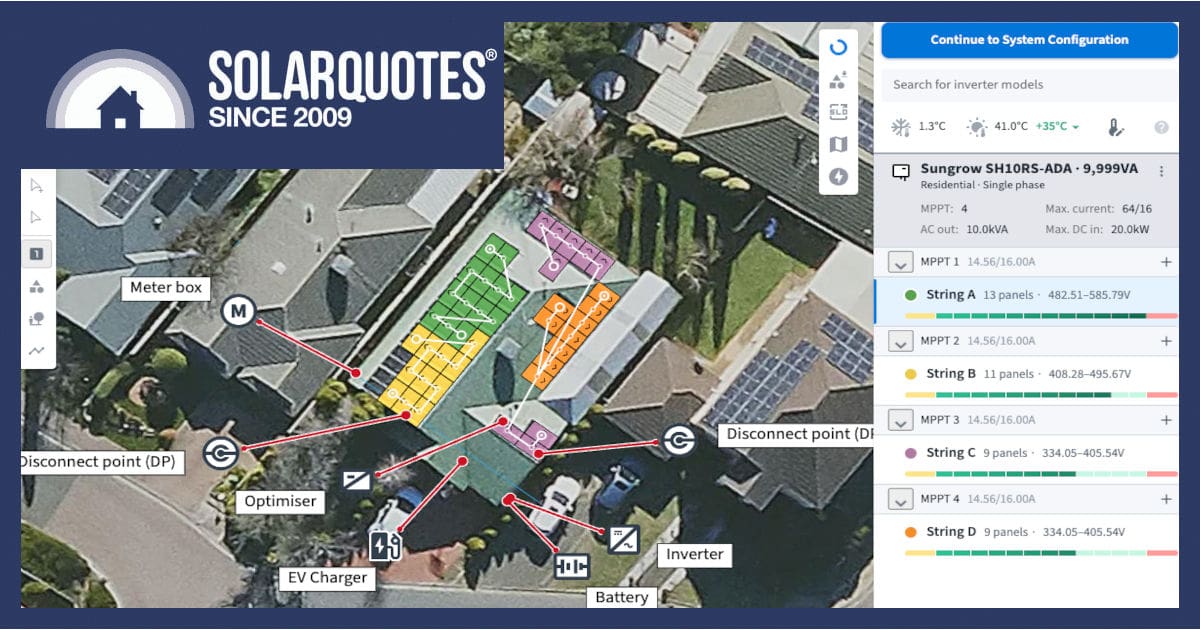
Like any complex modern technology, solar inverters often have flaws. In this post, I’ll explore one of the most curious problems I’ve seen in recent years. Thanks go to Sungrow for keeping my job interesting…
In my experience, Sungrow inverters are adaptable, powerful, and reasonably priced with great Australian support.
The hardware is solid1 so I’m surprised they have a fairly widespread technical problem.
What’s Going On?
In some cases, Sungrow’s 4 MPPT single-phase inverters can’t handle the string configurations they’re rated for.
While they still work, I have seen firsthand a system yielding only 150 watts when it should be pumping out 5000 watts or more.
I’ve noticed this before with a vintage Xantrex inverter that would “start-up” and turn the green light on but never generate properly. In that instance, it had to be replaced with an SMA that had quite different input specifications.
It can happen to any manufacturer. This just happens to be Sungrow’s turn in the spotlight.
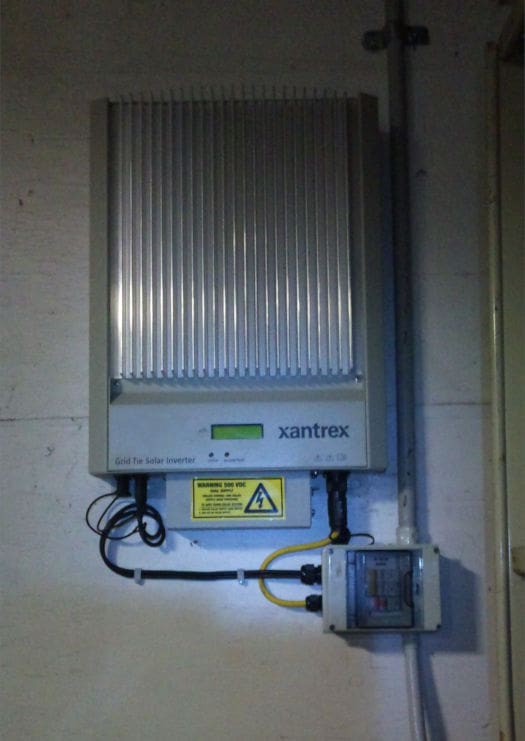
The lights were on, but nobody was home. Xantrex couldn’t cope with an array producing a maximum of 220VDC, and the peak power input of 180VDC was too low.
Of All The Gin Joints…
Let’s face it: If you were going to sell a new model line, you really wouldn’t want the General Manager of SolarQuotes to do beta testing in his own house. You could say it’s pretty embarrassing, but I prefer to look at it like this: What better way to prove your problem-solving prowess?
Trev, our GM, isn’t an electrician, but he’s technically savvy. He bought his new Sungrow SH10RS hybrid from a well-regarded business, and I’m comfortable saying the owner and electrician, Joe Deionno, is one of the sharper knives in the drawer. Joe’s experience ensured there wasn’t an installation or electrical design problem; everything was within the recommendations.
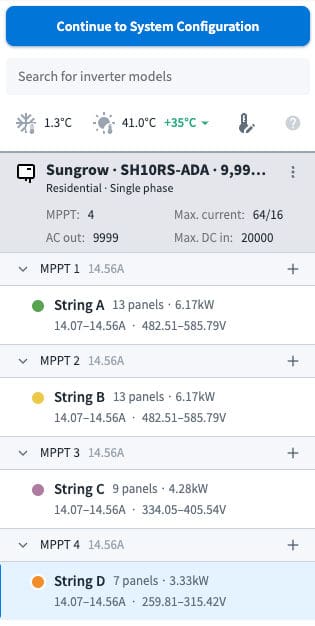
String D with 7 panels. At maximum power, there’s a 180-volt difference to string A
Sungrow Specifications are Impressive
Sungrow and many others have been kicking goals with 5kW hybrids offering a handy 27 amps (120%) surge capacity on the backup circuit. In an outage, this allows you to run your fridge and lights comfortably and even manage some luxuries like a small split system air conditioner.
The new 8 & 10kW (SH8.0RS and SH10RS) single-phase hybrids are a significant step forward. At nearly 60 amps surge capacity and up to 45 amps continuous, they’re designed to offer “whole-home” backup.
The inverter carries all the power to and from the grid2 It makes the installation wiring straightforward, but that simplicity cuts both ways. If the inverter fails, you have no power, so Sungrow supply them with a bypass switch.
It’s something we highly recommend for any series hybrid inverter. If the hybrid inverter fails, with a flick of a switch you, your tenants or guests can restore mains power and avoid emergency callout fees for a temporary switchboard rewiring job.
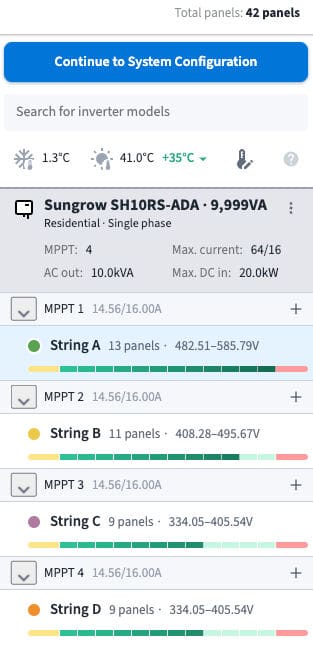
String D is now 9 panels. At maximum power that’s only 150 volts different to string A
There’s Been Some Confusion
For Trev’s place, there were a few months of maddening symptoms. Inconsistent faults are the worst. The firmware was updated, the wiring was checked, the battery was inspected, the inverter was replaced, and the monitoring was interrogated again and again.
Voltages were measured, SAPN (the electricity network people) were harassed about their external export controls. Even though the system had a dumb 5kW limit, it was moved to the new flexible exports just to see if that changed something, and it didn’t.
The disappointment became palpable with each round of phone calls and installer appointments. A battery cell with an early-life failure under warranty confused matters. In retrospect, Trev says the support was great.
An Interesting Development
At the same time as Trev’s woes, Sungrow tech support made a post on Facebook to alert installers of a potential problem. Subsequently, there were some dirty deletes, wild rumours and innuendo, culminating in an official explainer from a most senior technical engineer:
Hi Installers, Please be noted that, for SH8/10RS, the different MPPTs need to be within 150V.
This was the problem with Trev’s system. By moving two panels from one side of his house to the other, his string voltages were better balanced (within 150V), and the problem hasn’t resurfaced.
Sungrow gave a further, official explanation on Facebook:
UPDATED: Yesterday night, we organized an emergency technical meeting with Sungrow’s product team, now we can confirm that SH8.0RS and SH10RS have 4 real independent MPPTs, but, under some extreme conditions, the inverter could reduce solar production.
This Probably Looks A Bit Unseemly
Social media has become ubiquitous, forming the backbone of technical information and product awareness for many solar manufacturers in Australia. To be honest, I feel a bit awkward airing the dirty laundry, so I hope Sungrow isn’t mad at me. We’re demonstrating a culture that helps everyone by being well-engaged and super-responsive. Good manufacturers have a brand and a community, too.
The take away is the message that Sungrow offers great support for their installers, which means end users should have the best overall experience.
Those who just look over the promotional flyer can still be misled if you miss the asterisks and fine print on the next page. ** Please refer to the user manual for the full load MPPT voltage range
The Solution; Designing For Rated Power
While the operating specs are very broad, technical support now states designs should stick to the “MPP voltage range for rated power”
190 – 480v are the magic numbers (a 290 volt window) because, to quote Allen Ding from Sungrow,
“160v on one string and 530v on another is too much difference”
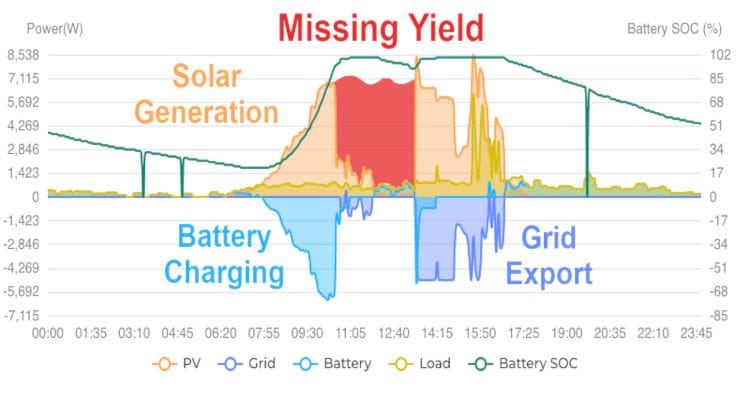
Trev’s solar output would sometimes drop like a stone and stay low for hours.
Innovation Continues
Now installers are aware, it’s not a huge issue, but it has spurred further development in the industry.
Designers and salespeople rely on software to place panels and form electrical layouts. Most use maximum open circuit voltage as a ceiling. With a particular panel at your address, uprated for low temperature, the programs will flag a design that exceeds 600 or 1000VDC.
I’m happy to report that, as a direct result of “the Sungrow situation,” our friends at solar design software SolarPlus are working out an option for nominal design voltage instead of just a maximum ceiling figure. So, all installers using all brands will be able to stipulate whether they want peak efficiency or peak capacity when designing.
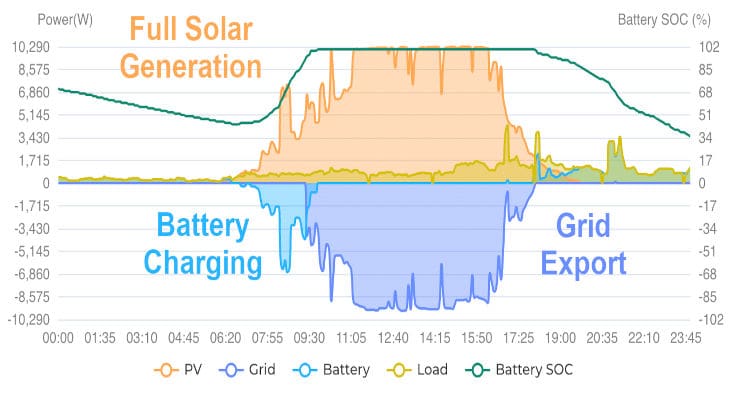
Once the string voltages were sorted out, Trev’s system has been cracking along
Quality Is Important, Support Is Supreme
At the end of the day, customer satisfaction can only be guaranteed by good service. You just don’t get it with crazy-cheap systems, especially those flogged by flimsy sales companies and spruiked by washed-up sports ball players on TV.
Not every solar power system is plain sailing. Trev has had a textbook case of new system difficulties but an even better example of stellar support.

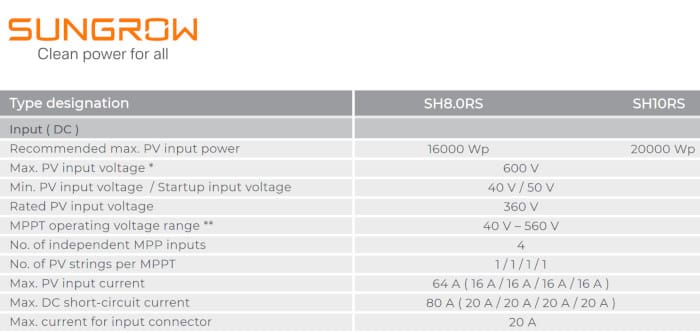
 RSS - Posts
RSS - Posts



I have a Hybrid Sungrow SH5K-30 inverter which controls battery and grid Output. Battery 2 X LG RESU12 with RESU Plus combiner box.
Also a Slave Inverter Solis. Each inverter has aprox 6.7 kw panels. Whenever there is lighting the RCD on the Sungrow inverter trips. This seems to have become more frequent over recent years. It is a holiday place so someone has to go and re-set the RCD and if not quick enough restart the batteries.
The electrician has checked the earthing, upgraded the RCD from 25A to 32A. Next step is to replace the RCBO with a circuit breaker.
Hi David,
Many installers use a standard circuit breaker on solar inverters.
While AS3000 calls for RCD protection on -all- final subcircuits, you can argue an inverter is a supply, so it’s not caught under the rules for consuming loads.
Many inverter makers specify an RCD with 100mA rating, but AS3000 doesn’t recognise anything over 30mA so that’s a moot point.
I wonder whether voltage difference between strings can be a general problem for the smarts on inverters causing limitation on power output.
I have a Goodwe inverter with 2 MPPT’s, and a low pitch roof without shading 10am – 4pm. For some reason (potential shading from TV aerial?) my installer arranged the strings as a 12/4 split on 16x390W panels.
In mid-summer at max solar input, the maximum watts per panel is just over 300W @ 395V on the 12 panel string, and about 350W @ 120V on the 4 panel string. The 12-panel string amps drops away from the expected parabolic peak between 1030am and 3.30pm.
Hi Jim,
If it’s a 5kW inverter or a 5kW export limit you might find the inverted current curve of one of the strings is simply because the machine can’t pass any more energy through.?
Possibly – I believe the inverter is export limited, but even at peak solar input, the export (on a nominal 6.24kW system) doesn’t go much above 4.8kW.
Hi Jim,
Might eb worth checking the AC grid voltage then.
https://www.solarquotes.com.au/blog/solar-voltage-rise-drop/
We have a SH10RS inverter with 6.5KW of panels and a battery. In our installation only MPPT 1 amd 2 are connected. I wonder if this explains the drop in output we’ve seen since we replaced our previous inverter last year.
We were onto this almost 12 months ago. Very annoying, for us in the early days, and we educated Sungrow about this….but when you do balance out those MPPTs voltages, my goodness me, these Sungrow systems are superb. I’m regularly punching out over 100kWh per sunny day on my 10kW SH10RS Inverter with near 200% oversized DC array (with batteries)
This is the best Hybrid inverter on the market in my opinion… Even with their MPPT issues.
I have 3 out of 4 MPPTs connected and no such problem. Having said so, Azimuth difference between the connected panels strings is below 10 degrees and 8 vs 6 panels is not a dramatic difference. You can always experiment with blanketing one of your strings on a sunny day and see what happens, right?
I wonder whether improving the graphical display, to include power from each string of panels, separately, would, apart from being more informative, assist with diagnosing such problems.
Perhaps, an additional graph, in parallel with the graph as displayed above, dedicated to separating the power output of each string, separately, would be useful, in the monitoring of the performance of each system.
This refers to not only the Sungrow SH8.0RS and SH10RS inverters, mentioned above, but, to all inverters that have capability involving more than one string.
If the manufacturers cannot provide this additional functionality, then, perhaps, the manufacturers could be willing, upon request, to provide sufficient information for software developers to be able to retrieve the data directly from the inverters, for analysis, which, if done on a local basis (inverter -> wifi modem -> local computer), could also avoid or minimise problems arising from the increasingly unstable cellphone networks (4G networks becoming increasingly erratic), which, at present, causes monitoring via the Internet, increasingly haphazard.
And, if the inverter manufacturers would provide the information to software developers, to retrieve data from the inverters, then applications to continually analyse the performance of the PV systems, could be developed to run on local computers, without being limited to particular operating systems (for example, the sigenergy mysigen-app, apparently, can be installed and run on local computers, but, only for MS Windows and MacOS operating systems, and, then, probably only on particular versions of those operating systems).
And, many software developers, including, especially, open source software developers, are interested in developing software for retrieving data from PV inverters, for analysis.
Hi Bret,
Sungrow certainly does this with their monitoring platform if you know where to look:
Thank you for that, Anthony.
With my Goodwe EH5000 inverter having failed some weeks ago (at about two years after installation), and Goodwe obfuscating about fixing the problem, I increasingly believe that I should have instead got a Sungrow SH5.0RS
Hi Bret,
GoodWe are pretty solid in my experience, close enough to Sungrow that many installers treat them as equal, and certaily a cut above Solax/GroWatt/SAJ/SoFar and so on.
I wouldn’t give up on GoodWe as I’ve found their support to be quite good, but please let us know if there’s something we can do to help.
Cheers
I have now given Goodwe until Friday to get our whole system fully operational, after which time, if this deadline is not met, I intend to make formal complaints regarding what has happened. And, I expect for them to pay for the power bills resulting from their lackadaisical attitude.
Having paid 26000AUD for a system with a 19.3kWh BESS for a UPS, and, a month over a catastrophic system failure, with the system being less than 26 months old, and, being stuffed around by Goodwe, with no resolution in sight, I am completely fed up with them.
And, I now, strongly recommend against Goodwe and its products.
Hi Bret,
I’ve forwarded your complaint to GoodWe myself because in our experience they’re very good at support.
All manufacturers have technical and warranty lines answered by people who largely read scripts. Getting a complaint raised to the right level is sometimes problematic.
Hopefully they get it sorted shortly.
Hi mate I have replaced 2 goodwee inverters over 7 yrs and no warranty because the installers went bust (country solar ). Thanks Mark W
Hi Bret, as with most products and services, there is a conflict of interest. If you put yourselves into Sungrow shoes, would not you like to retain as much control as possible rather than publishing API of that inverter? Surely with the right techniques the traffic between the inverter and Internet can be sniffed and decrypted, and likely there are some solutions on the github.
Expecting from Sungrow to part with total control over your inverter is like expecting these days Microsoft to give you control over your? Windows computer.
Why do you think Sungrow inverter does not have functional controls on itself??? Why do you think their inverters and batteries are not compatible with anything except Sungrow?
From my experience so far, Sungrow is worse for my energy security than Huawei for communications security.
Hello, Nick.
I do not use MS Windows.
I use Linux Mint Mate 21.3 (https://www.linuxmint.com/) , slightly modified to suit me (I use a deprecated interface, that I have found and store, in addition to on the computers, on a Ventoy drive, for installation to new installations).
I have looked for Goodwe and Sungrow on github, but, have yet to find packages for them.
I did find this https://www.pvoutput.org/about.html , which is interesting, but, it does not provide all of the functionality that I want, but, I have joined it for monitoring overall output on a daily basis. It enables automated updating and monitoring, for some inverters, but, once again, the automation apparently does not extend to Goodwe and Sungrow, although, I would be hesitant in providing my account login details, when the Goodwe and Sungrow user interfaces provide for some configuration of the inverters, in addition to the performance monitoring.
Hi Bret,
I guess your OS limits your choices because most software is written for Windows. Also, I toyed with Linux Mint when Win10 was bestowed on us, but quickly figured out that by design it can’t have APPLICATION firewall, but that is beside the point.
ATM I do not want to invest my time into managing my Sungrow inverter from my LAN. To me it is clear that Sungrow is actively acting against my interest, therefore I need to return it as not fit for purpoce, and find something that is my friend. That is where I need to spend time when I have it.
Definitely I am not going to invest that much into Sungrow batteries since Sungrow is that hostile to my interests.
Nick – whilst I could not easily find the information from your above posts, with your reference to having 4 MPPT’s, I assume that you have a Sungrow SH10RS inverter (I believe that some lesser capacity Sungrow SH*RS inverters have also, 4MPPT’s, but, I have a memory of seeing a reference to you having an SH10RS).
You have referred to absolute (and, you infer, malicious) control, exerted by Sungrow, in now limiting supported compatibility to Sungrow BESS’s for Sungrow SH inverters.
From my understanding, perception, and, belief, having the same brand of BESS, linked to a hybrid inverter (Sungrow BESS linked to Sungrow SH inverter, Goodwe BESS linked to Goodwe hybrid inverter, etc), should simplify any remedial pathways, in the case of a system failure, where the BESS/inverter combination, is not working as it should, removing the prospect of demarcation excuses between a separate BESS manufacturer and hybrid inverter manufacturer. Someone from Solar Quotes, can better explain that.
You refer to Sungrow exerting total control, against your interests (“Expecting from Sungrow to part with total control over your inverter is like expecting these days Microsoft to give you control over your? Windows computer.”). Perhaps you are not aware, but, on a single phase electricity grid connection on the SWIS grid in WA, PV inverters with a capacity of more than 5kW, are banned, thus, the Sungrow SH10RS inverter (and, other brands’ equivalents) is banned from the SWIS grid, in a gratuitously malignant policy by Western Power and the WA state government, which both regard 5kW of power being exported to the grid, as being less than 1.5kW of power being exported to the grid, and therefore, the 5kW exports to the grid, placing less of a burden on the grid, than 0-1.5kW exports to the grid, and, the SWIS grid single phase inverters that are allowed (<= 5kW), can, maliciously, be remotely shut down, for the amusement of Western Power.
We are bullied by SWIS grid coercive control.
Hi Bret,
Get an SpPro and you can stick it to them 😉
https://www.solarquotes.com.au/blog/selectronic-sp-pro/
Hi, Pieter from the Netherlands.
I am a Certified installer.
Here it’s not a problem to connect a hybrid Sungrow to a BYD battery
This isnt about your article; this is a complaint, and a plea for help.
I want to drive my ev from Sydney to Wagga—I looked up ev charging stations, but it is so confusing. There seems to be one at Pheasants Nest—but one has to phone ahead to find out if it is available—-but what number?
There is one at Gundagai—off the M31 somewhere. Is there one at Yass?
The government ev charging website says little. The Plugin website shows a forest of yellow and orange markers, but gives no detail. It is an American site anyway.
I do admit that, well, I wish I could be more intelligent and savvy…….
How is an ordinary dummy going to find out
1)where the ev charging stations are, exactly.
2)if they are available, in working order
3)what the charges are……..
Hi Robyn,
Have you tried this one…
https://abetterrouteplanner.com/
You can also use a standard google map view and search for “EV charger”
Plugshare is another option.
Jointing the actual charging networks. ie NRMA, Jolt, Evie etc and they have locations with availability.
Or this is another option for advice…
https://www.facebook.com/AEVANational/
How can Sungrow say they have 4 independent MPPT’s when a voltage difference of 180V means the inverter basically tanks?
The product doesn’t meet design specifications and should be recalled under Australian Consumer Law as they were not sold with this limitation clearly stated, therefore they are not fit for purpose.
Good service does not make up for poor engineering.
The outputs of the 4 MPPTS must necessarily combine at the AC inverter input, and each is a DC-DC converter. Even a well designed Buck-Boost converter cannot handle an infinite variety of input and output voltages – like a gearbox, it has limited operating ranges. Now hook up 4 of them. They are no longer independent in terms of power delivery, as the outputs are locked, voltage-wise.
Another analogy is 4 pressure pumps feeding a common pipe from separate sources, each with a different input pressure. If the feed pressure to one is very low, and another very high, then one may need to shut down or at least idle, to keep the system stable.
Remember that if one MPPT is at 180v, and another at 600v, then one is boosting 180v to more than 325v to reach 230 Vrms’s peak voltage, while the other is bucking (down converting) from 600v.
More balanced inputs are easier to handle. E.g. Four horses pulling one plow, with one horse on firm sand, one on loose sand, and two in deep mud. Will that do as well as with all on firm sand? Nope, the close system coupling forces the good one to drop back to cope with system imbalance.
Before calling bad engineering, it helps to have some sense of engineering limits, and be able to read datasheets, perhaps?
Didn’t the article state that the (asterisk-marked) combination limits could in fact be found on a following page? Remember, “operating range” is not in any way the same as “rated power operating range”. They are both legitimately useful things to know – and preferably understand.
Hi Erik,
You make an eloquent point, thank you.
I guess what we’re trying to do is make people aware that these limitations can cause some grief if you’re not across them. It’s a tiny bit disingenuous to advertise a very broad operating range and then add some fine print on another document that clarifies this isn’t quite so.
It’s a bit like Tesla claiming ludicrous** acceleration times on cars at the drag strip.
(with a rolling start)
Hi Anthony,
Yes, fully agree. Full disclosure would ideally have put the input disparity limit on the next line in the table showing Max and Min figures. A system designer needs to be across both, to avoid the pitfall, as your article sets out.
Instinctively burrowing after asterisks is perhaps more natural to a design engineer, used to dealing with dozens of component datasheets, each with “Absolute Maximum Ratings” in the first table, then “Recommended Operating Conditions” in another, followed by yet more tables and graphs. And those tables usually have small easily missed superscript numbers sprinkled about, each with a matching footnote following the table. You learn to be a bush lawyer – trust nothing, design for worst case, check it all again. (All fine when making a million off, but too much for a one-off customer design.) Then obscurity isn’t playing fair.
My slight elbow dig was responding to the comment loudly confusing a poor datasheet with poor design. A better datasheet could have avoided the whole problem. Your article, widely disseminated in the industry, can though obviate a pile of pain.
Many thanks for keeping us informed.
I’ve had another look at this on my SH10RS, and I wonder if you’re 100% accurate in your reporting. My inverter has only MPPT 1 and 2 connected, and so MPPT 3 and 4 are almost always hundreds of volts below 1 and 2. I don’t see that this significantly affects their output… or am I missing something?
Here’s a link to my graph from yesterday showing all 4 MPPT voltages.
https://ibb.co/2dFkfmz
Hi Anthony,
I don’t think Allen gave the wrong advice. I remember we do have an MPP voltage range for the rated power, which is optimal. I spokes with Allen before, and he’s a nice guy. I don’t think his name should be brought up in this dispute.
Thanks
Luke
Hi Luke,
We’re not disputing anything and neither is Allen, he’s just stating the issue as he and Sungrow see it.
Thanks for the constructive feedback though, it helps everyone when we’re all better informed.
Cheers
Cheers
After trying Growatt, which was actually operational without connecting to the grid or a battery, but was unacceptably noisy, I was sold Sungrow 1-phase Hybrid Inverter SH10RS. It is the only fanless inverter I know, and it has 4 MPPTs to take 3 strings of panels with slightly different orientations.
I was under impression that I would have some choice of batteries to use with that inverter. Growatt could even use lead batteries. To my surprise, BYD (which I suspect is at a heart of many brands) does not list SH10RS, only 6.0RS. The doc is 2023-01-30 and there was no SH10RS back then as far as I know. I could not find anything up-to-date from BYD.
I reached out to Sungrow, and received a short answer: “Our SUNGROW Inverters are not compatible with OTHER brands of HIGH voltage battery anymore.”
“ANYMORE”! So, people were installing Sungrow inverters and suddenly they became not compatible and the only choice is a Sungrow battery, as if absence of a functional controls on the inverter itself was not disturbing enough! They clearly force you into their ecosystem once you touch their brand. That is why I never use Apple.
From my long experience with installers and platforms like https://app.getpylon.com/ my impression is that Solar business is corrupt in many respects. I do not have other explanation how government banned Huawei on communications security grounds, but does not ban Sungrow on energy security grounds. At least after that email from Sungrow, they are not my choice for my own energy security, even if I find software to manage the SH10RS locally without it being commanded from Internet.
But what choice do we have?
Frontus has only 2 MPPTs and a fan known to make noise and being a point of failure. Taken the Europe has been a run-down place for quite a while, I don’t have high hopes for Frontus to come with something to rival what China has to offer or be future-proof.
The only industrialist left in today’s America has AC-coupled batteries, but their 2
Hi Nick,
An inverter and battery from the same company simplifies warranty. There was a time when Victron & LG fell out of love and neither of them would honour warranties because nobody want to pay for testing and approval of a combined product.
If you want security, reliability, choice of battery and local content then there’s only one choice.
https://www.solarquotes.com.au/blog/selectronic-sp-pro/
Get your wallet out and be pleased that you can buy a first world solution with absolutely first rate local support. It’s what I did.
Cheers
Thank you Anthony, tried to make sense of what I could find on their website. What strikes me first as an IT person is the quality of the website and the videos, as if they can’t speak a single English word at all. Downloaded the datasheet.
The first advantage they list is Australia-made, as if Australia is likely to technologically catch-up with China in my lifetime (if you’ve ever been to their technocities).
Maybe I do not understand what ‘grid-forming battery inverter’ is, but my objective is to have a single phase 10kWt hybrid inverter with at least 3 MPPTs capable of voltage delivered by a string of 8 Jinko JKM440N-54HL4R-V.
In that datasheet there is nothing about MPPTs. I made a request to their support using the website. Received email to confirm my email address. Found that my message is flagged as Spam. All that over unencrypted connection which these day is unheard of!
Are you sure you sent me on the right track of replacing my SH10RS?
Hi Nick,
A Selectronic SpPro is an inverter charger. It turns 48VDC into 230VAC. ie it forms an AC sine wave which is the “grid supply” for your installation.
(Or it takes 230VAC from the grid, a generator, or inverter and charges your battery)
Adding solar needs components.
Either a Fronius or Fimer inverter, AC coupled to the SpPro output and synchronised to power the AC loads in your house. This source can be twice the size of the SpPro and is actively controlled, throttled on or off once the battery is full.
And/or you can have a DC charger controller, otherwise known as a battery charging regulator or MPPT.
The best MPPT charge controllers are made in Australia by AERL… they invented MPPT technology. You can add as many regulators as you like because they charge the battery with Direct Current from the solar at 40 to 60 volts. Once the battery is full they just throttle off. There’s no DNSP connection so no permission needed nor rules for more solar.
You can’t export with an SpPro because the network rules won’t allow it.
It isn’t something that competes with a lightweight hybrid like Sungrow, rather it’s a low frequency toroidal transformer which at 45kg (for the smaller models) and 240% surge capacity will grind chinese things to dust.
Selectronic have been established for 60 years. They warrant the inverter for 10 years and they’re known to service working 20yo old units with a new fan and capacitors (there’s a counter which tells you their life) and send them back out for more. Everything else in the system can be replaced or upgraded piece by piece without being bound to a brand or specific technical integration.
If you want advice on one the best approach is to contact an installer who specialises in remote area work using Selectronic.
https://youtube.com/shorts/wWgOu7xgPGo?si=t41tsRhG03VOSEg1
Nick – the document at
https://service.sungrowpower.com.au/TI_20210824_Approved%20battery%20declaration%20for%20sungrow%20hybrid%20inverters_V16_EN-1.pdf
pretty much confirms what you said;
”
SH5.0~10RS, SH5.0~10RT Series, SH15T~SH25T Series Hybrid Inverters ,
ONLY support SUNGROW SBR& SBH series High Voltage Batteries,
Other brand high voltage batteries are no longer supported.
Please refer to the below document and link for the details of compatibility and
design requirements.
https://service.sungrowpower.com.au/GD_202405_SBR%20and%20SBH_Cross%20Ref
erence%20Chart_V1.4%20Final.pdf
”
One thing of interest (to me, anyway), is that the document at
https://service.sungrowpower.com.au/GD_202405_SBR%20and%20SBH_Cross%20Ref
erence%20Chart_V1.4%20Final.pdf
in the table for the SBH range, shows that for the SH5.0RS inverter (and, applicable also to the SH10RS inverter), the inverter is compatible with the SBH250; 25kWh capacity BESS, and, in that, the Sungrow SH5.0RS can handle a bigger capacity same (as the inverter) brand BESS, than the Goodwe EH5000 (the almost equivalent Goodwe inverter), which has a maximum capacity same (as the inverter) brand BESS of 19.2kWh (LX F19.2-H-20) –
https://en.goodwe.com/Ftp/EN/Downloads/User%20Manual/GW_Battery%20Compatibility%20Overview-EN.pdf
.
An advantage to having the same brand BESS as the hybrid inverter, is this; after about two years after installation, my Goodwe EH5000 inverter carked it, and the BYD HVM19.3 appears to be dead. After about a month after the catastrophic failure of the system, Goodwe are yet to replace the inverter, so, no UPS ((with power failures), and, when they do get around to replacing the inverter, the state of the BESS, is yet to be determined, and, if the BESS, as it appears to be (no lights are on, on it), then demarcation issues can arise (Oh, so what if our inverter killed the BESS – that is not our problem, as the BESS is not our brand).
Just wondering if there would be any impact from mppt strings facing different directions. A west facing and north facing mppt set, especially in winter would likely be very different at the start and end on the day.
Hi Brad,
As soon as there’s any amount of light on a solar panel the voltage will come up quite close to open circuit specification. Once the sun breaks the horizon voltage will be quite good, however the amount of current they’ll provide depends on the intensity of the irradiance measures in watts/m²
Thanks for reassurance, i was a bit nervous. I’m getting a 10kw sungrow hooked up tomorrow and itll have 1 empty mppt, 1 tilted west, 1 flat and 1 tilted north.
I prefer to remain anonymous here for the reasons I will point out. While the industry appreciates feedback and honest reviews, it is bad form to publish someone’s name, unless they have given approval to do so. Statements can be taken out of context and give a false impression of what was discussed. All reputable brands have teams of technical staff who will always resolve issues as soon as possible. This may mean a redesign, which can take a while. But as long as manufacturers work on and resolve technical issues, then that’s the best possible service. I have been in the industry for a very long time and have seen the difference between a manufacturer standing by their warranties, and those who ‘switch off’.
Thanks Anon,
We’re all about full and frank feedback so if there’s some confusion or point of fact that needs to be addressed, we’re more than happy to make corrections. Please reach out privately if you need.
We are the first to acknowledge we don’t always get it right, it’s equally a matter of pride that we will edit or make notes on our published pages to explain errors and make good on things we may confused or cocked up.
This particular issue was one we’ve been aware of for some time and we didn’t want to besmirch a good reputation by going off half cocked. Equally it was something that the solar buying public needed to be aware of because if it’s happened to us then there has to be others who have suffered the same difficulty.
If we’ve mentioned names it’s because we want to make sure everyone knows this isn’t a hatchet job. We’ve been in contact with consumers, with installers and with Sungrow themselves.
The take home message is Sungrow offer great support.
Cheers
Hi Anthony,
Please excuse my ignorance, but does the Sungrow SH10RS have a bypass switch built-in, or is this something the installer adds in the installation process?
Hi Paul,
The bypass switch is supplied in the box by Sungrow but it’s fitted in your switchboard.
https://www.solarquotes.com.au/blog/hybrid-solar-bypass-switch/
This seems to be what I’m going through right now with my 3 phase hybrid Sungrow inverter.
Every second day I’m having massive drops in production, sometimes for most of the day. It’s been very frustrating.
Thanks for the article, I’ve forwarded it to my installer & hopefully this can be fixed.
Hi Jo,
To my knowledge it’s only the single phase units that have been prone to this issue but let us know how you get on.
Cheers
When I took out house insurance I advised my insurer that I had a solar system. I asked them does my insurance cover any damage to my house if there was a fault with my solar system. They would not give me a definitive answer. Where do I stand legally for a claim.
Hi Ross,
I think it’s pretty straightforward. Solar is a hard wired appliance, a permanent fixture to your home. It’s screwed on the wall, so unlike furniture, you can’t take it away after you sell the place.
Bear in mind I’m not a lawyer but the best advice I can offer is that if your solar power system is damaged in a storm; then don’t tell them any more than that. Power surges, spikes & interruptions are all things that might be in the list of exclusions, so don’t give them an excuse.
I have a solar system of 20 panels sungrow inverter SH6 ORS (AS4777-2)(2020) and 12.8 battery storage all installed by ARKANA now trading as 1KOMMA5.But what was supposed to be and stand alone system but still grid connected, I now find that when grid connect switch is off I still do not have complete house power, on contact with ARKANA, I was told that my inverter is in sufficient to power the whole house, is this with regard to the inverter correct,.and they request that I pay for the upgrade, This is not what was intially agreed.
Hi Ralph,
What was documented on your quote?
I try to explain to people that if you want to treat the grid with contempt, you don’t want a lightweight hybrid, you need a decent machine designed for the job.
In any case you’ll need a backup generator in winter and the best one isn’t diesel, it’s a grid connection. Cheaper, more reliable, better quality, more robust.
The smaller Sungrow units only have around 27amps throughput on the backup circuit, even when the grid is available, so they’re not suitable for a whole home backup. We have had customers find this out the hard way and wrote this article in response.
There may be a way to connect your whole house and have the Sungrow unit back it up but I’m still working on the best diagram to explain it at the moment. In any case you’ll need to have modest loads when there’s a grid outage.
Moving to a 10kW hybrid might be the best way to get more solar on your house. Or adding a 5kW grid connect inverter downstream of your existing hybrid would also be a possibility that gives you more capacity when the sun is up, even if there’s an outage.
Okay.
I have the opposite problem… generating more output than the system is rated for or could possibly produce.
Installed a 17.6kW system in early June this year.
– 39 Trina Vertex panels on 4 strings connected to the Sungrow SH10RS inverter and Sungrow SBE128 battery.
Technically, the system could produce a maximum of 17.2kW under perfect conditions (39 panels x 440 watts = 17.2kW)
But with 30 of the panels on a 15 degree south facing roof, I was allowing for a 20% to 30% drop in output due to less than ideal orientation. (The other nine panels on the 4th string are near perfect north facing and good angle (27 degrees).
I was hoping for a maximum output of 13 or 14kW and but expecting that until peak summer.
So imagine my surprise the other day when the system peaked at over 19kW.. and this was on a good sunny day but not boiling hot so not really the sunniest.
Now, reading this article, I am wondering if my wonderful Sungrow inverter is perhaps faulty….. and not really working that well at all?
Should I be on the phone to Sungrow?
W
Hi Williem,
I don’t think you have anything to complain about whatsoever.
Your solar can perform better than its sticker rating because of temperature.
The modules are tested at 25°C & 1000w/m² so if the temperature is lower they over perform. If temp is higher they won’t deliver as much, usually at a rate around 0.4% per degree.
Have a look at longer term kWh yield and you’ll see south facing solar isn’t quite as good. (Not that it matters a lot)
Try putting your details into PV Watts from NREL and you can get a good idea on yield.
150V doesn’t sound right to me. Last year, we checked with Sungrow about this, and they said they had no solution. So, I changed the design. But the independent MPPT needs to handle more than that.
They can deny 160V and 530V, though, since their datasheet states those are outside the rated range.